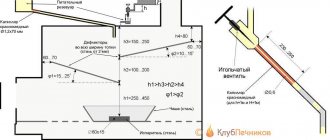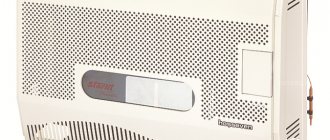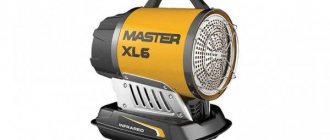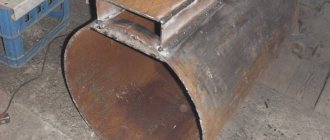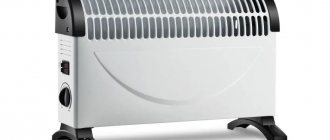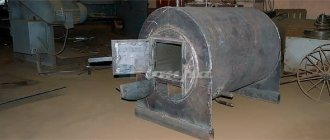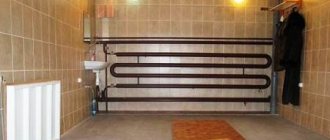With the onset of cold weather, people begin to think about how they can heat their home, cottage, garage, office and other premises. One solution is to purchase a diesel heater. In the modern world there are no problems with choice, because the market offers a large assortment of these devices, which differ in operating principle, manufacturer and cost. In this review, we will help you decide on the type and model of diesel heater.
The design of a diesel heater and its operating principle
The operating principle of a diesel heater is very similar to an electric one, but the difference is that the former runs on diesel fuel, while the latter requires electricity. The diesel fuel heaters package includes:
- The combustion chamber;
- Spark plug;
- Motor and fan impeller;
- Pump;
- Filters for air purification at the inlet and outlet;
- Fuel tank;
- Controller;
- Pipes through which air flows;
- Flame stabilizers;
- Fuel nozzle.
Diesel fuel is poured into the tank, from where it enters the combustion chamber.
Next, the fan will fan the air to ignite the fuel. Filters clean the air from various particles and combustion products of liquid fuel, and controllers regulate the air temperature. See also -
How to choose an inverter heater for home and street
Heating device from a gas cylinder
To assemble such a diesel stove you will need:
- seamless balloon with a wall thickness of up to 1.5 cm;
- fuel capacity 8-15 l;
- smoke exhaust pipe 4 m long and with a cross-section of 10 cm;
- copper tubes for burner assembly;
- steel corners 20 cm;
- welding machine and grinder.
Diesel fuel will flow into the combustion chamber by gravity without forced air injection. The size of the outer contour of the stove must correspond to the height of the flame so that the device does not heat up to too high temperatures. The walls of the device should not be too thick so that the hot vapors generated reach a certain temperature. An empty gas cylinder must be divided into 2 parts - the upper one will serve as the lid, and the lower one will serve as the combustion chamber.
On the side of the bottom of the cylinder you need to weld the legs from the corners. On the opposite side, moving 10-15 cm from the edge, you need to cut a hole for the chimney using welding. A pipe with a cross-section of 10 cm and a length of 4 m is suitable for this. It should be welded exactly at an angle of 90° to the body. It is necessary to cut a hole in the chimney to regulate air access and cover it with a plate.
Stepping back 10 cm from the welding site, cut a small hole of 2-3 mm. Next, retreating 5 mm each time, you need to make 9 more of the same holes - the last one will be located 50 cm from the welding site. In addition, another hole is made in the pipe for a pipe with a cross-section of 5-8 cm and a length of 2-4 m. It is welded parallel to the floor. A hole with a cross section of 5-8 cm is cut in the top of the cylinder to supply fuel.
Place of application of diesel heater
Heaters running on liquid diesel fuel can be used in different rooms. The place of application depends both on the dimensions of the device and on the size of the heated room. For example, small units, such as heat guns, are perfect for the garage.
Infrared diesel heaters will fit perfectly where it is necessary to heat the air in an open space: a cafe, a veranda. Note that this type of device is also suitable for indoor use.
Solar gas heaters can be taken with you, for example, on a hike, and you can cook food on it, and it is also perfect for heating a summer house. We will talk about all these types of devices a little later.
Where can it be used
Regardless of the type of fuel (diesel or gasoline), all catalytic heating devices have one important advantage - they can work for a very long time and are not controlled by humans. This means that such heat sources are fire and explosion-proof and can be used in everyday life.
Also, such stoves will find their use in garages, warehouses and workshops, in cabins and construction sites, and will heat a greenhouse, cottage or country house.
Mobile models are indispensable when camping - for heating tents and heating food. A gasoline portable heater is familiar to any traveler.
Types of diesel heaters
Heaters running on diesel fuel are divided into the following types:
- Stationary;
- Air;
- Infrared;
- Direct acting devices;
- Indirect acting units.
The differences between the last two are that direct heating heaters are not equipped with filters and air vents for combustion products. It must be remembered that when such a unit operates, the latter enter directly into the room in which it is located. Therefore, they are used in non-residential premises or for urgent repairs during cold weather.
Heaters of this type are characterized by a combustion control system. Note that it works in automatic mode. The large fuel tank allows for refueling every 10–15 hours.
Indirectly heated diesel heaters do not emit combustion products into the environment, which was achieved through the use of filters that purify the air.
These devices are perfect for residential premises. See also –
Are infrared heaters harmful to health or not?
Infrared diesel heater
This type of unit can be used to heat buildings with high ceilings, because they are usually installed on the ceiling or wall. Infrared radiation will help to heat even gazebos located outdoors.
Such heaters act similarly to solar radiation. When fuel is burned, heat rays are generated, aimed at heating objects, people or walls, which, in turn, already heat the air in the room with their heat. This helps save fuel consumption, which is undoubtedly an advantage. These devices are recommended for use in rooms that are characterized by poor thermal insulation or there are restrictions on the use of electricity or there is a shortage of it.
Air Diesel Heater
The operation of an air heater resembles the principle of operation of a fan. This unit is equipped with a durable housing that protects against overheating and mechanical damage. Heat guns, which are a type of air heater, heat a room through the movement of a warm air flow and are often used in non-residential premises.
The main feature of this type of heater is that it heats the room as long as it works. This means that if you turn it off, the temperature in the building will drop sharply.
Common types
Forced air heating devices are widely used. Thermal energy in them is created due to the combustion of diesel fuel. This heat is used to heat the metal or ceramic element, and when the fan is turned on, warm air begins to circulate and warm up the room. They are best used in large rooms, without air flow and drafts. Such heaters are very effective and inexpensive.
Infrared diesel heaters. Infrared radiation is similar to solar radiation; it warms up objects and people first, and then the air. Infrared heaters using diesel fuel are also installed. An important advantage of this type of heating is the instant heating of objects located close to it. The devices are well suited for rooms with drafts.
Diesel infrared heat sources consume electricity very economically, and by connecting a generator, you can create your own autonomous heating.
Due to the fact that diesel fuel burns completely, such devices do not require smoke removal. They are often installed outdoors and in street cafes. The disadvantage of such heat sources is their inability to warm large rooms.
If we compare air and infrared types of devices, the first is significantly inferior to the second, since it dries out the air in the room quite strongly.
Diesel heating boilers operate on the same principle as turbocharged gas appliances. Their similarity is also in easy control using electronics in automatic mode.
Compact appliances – a kind of potbelly stove with a fan – are very popular on the market. They come in 2 types:
- with direct heating (without chimney);
- with indirect heating.
The operating principle of a potbelly stove with indirect heating is very simple. Liquid fuel enters the combustion chamber, where it is burned thanks to the air supplied by the fan. Passing the heat exchanger, warm air rushes into the room, heating it throughout the entire area. This heating device is very often used in garages. The design of heating devices allows you to: control the fuel consumed and regulate the temperature.
Basically, all modern diesel stoves have a flame control system, which means that if the device overheats, it will automatically turn off.
Pros and cons of diesel heaters
Like any device, a heater that runs on diesel fuel also has its pros and cons.
Advantages:
- Compact size;
- Autonomy;
- Cost-effective – from a financial point of view, purchasing diesel fuel is much cheaper than purchasing electricity;
- Mobility – you can take it with you or move it to the most convenient place;
- Large range of heaters.
In addition to all of the above, modern models have additional functionality, are as economical as possible, and can be controlled remotely.
Flaws:
- High cost of the unit;
- High noise level during operation;
- Combustion products that can be released when heating a room.
Self-assembly
Do-it-yourself diesel stove
Diesel units are very popular because they run on diesel fuel and waste fuel. In addition, creating them on your own is quite simple.
Any type of metal is prepared for the creative process. The fuel is definitely diesel fuel: the stove works well with it and creates high-quality heating. True, the work gives off a nasty smell; you can’t install this in every dacha. Therefore, it is better not to use this model in residential premises.
Often the creation of a diesel stove is due to its subsequent appearance in the garage. There are versions of garage stoves with direct and indirect heating. The former do not have a chimney and are very inconvenient for the intended purposes. The latter have a fuel tank and a combustion section that operate in a simple way: the liquid passes through the reservoir nozzle and ends up in the combustion section. There it is burned thanks to the air sent by the fan. Air flows in transit through the heat exchanger follow from the nozzle into the room. A similar diesel model may have the following composition:
- adjustment screw,
- frame,
- burner,
- removable tank,
- lattice,
- removable block,
- reflector.
In addition to the removable tank, a valve is included in the stove, and a wick is included with the replaceable unit.
Specifics of diesel equipment
Modern diesel modifications have flame control technology. It turns off the device when it overheats. As already noted, these stoves can heat small rooms. The same garage stoves are also extremely useful for heating emergency rooms. It is diesel ones that can be taken outdoors. They are especially needed when it rains during a hike and there is no possibility of making a fire.
Why are diesel heaters better than others?
Among the main advantages are the following:
- Efficiency is about 90%;
- Economical fuel consumption;
- Fast and high-quality heating of large rooms;
- Wheels that help you quickly move the device from place to place;
- A variety of types of diesel heaters and their capacities;
- Economical electricity consumption;
- Combustion and safety control occurs automatically;
- Fuel tank - allows the heater to operate for a long time without refueling.
Drip type oven
This design is suitable for small spaces, such as tents, and is quick and easy to assemble.
The build method is:
- Select a box of the appropriate size, for example 30x30x45 cm for a room of 3 m2.
- For the stove cabin, take a fire extinguisher body or a large 200 liter tank if a large heater is needed.
- For fuel, use a 2 liter medical burner. A thin copper tube 1 m long, bent at 90°, is attached to its rubber hose.
- The flexible hose is folded in half and a clamp is attached to the bend to secure the stove parts. The screw is mounted in such a way as to ensure a drip supply of fuel.
- A wick made of rags or old cotton briquettes soaked in diesel fuel is placed inside the body.
- Secure the door.
- In the center of the case or closer to the door, you need to drill a hole for the cross-section of the copper tube.
- At the end, the wick is set on fire, combustion is ensured by slowly dripping diesel fuel onto it.
Criteria for choosing a diesel heater
Undoubtedly, every person, before purchasing any unit, adheres to certain criteria that he gives preference to. When choosing a heater, the criteria may be the following:
- Air exchange. This indicator is very important for heat guns. The higher this value, the stronger the heat flows accelerate, and, consequently, the room heats up in a short period of time;
- Fuel consumption. It must be taken into account that 1 liter of fuel should produce approximately 10 kW of power;
- Direct and indirect action. For the first type of heaters, additional ventilation is required, because... combustion products enter directly into the room. For this reason, they are not practical for use in small and confined spaces. Indirect-acting units are equipped with filters; unlike the first type, they are not as economical;
- Possibility of changing modes. It is very convenient if you can change its power while the heater is operating. It is also economical, because some devices, with minimal heating, can operate without refueling for two weeks
- Timer. With its help, you can set the time during which the heating will be intense, after which the heater will turn off;
- Noise. When a diesel heater is operating, there will be noise in any case. This is a fundamental indicator and must be taken into account. Note that a figure of 45 dB can be considered suitable;
- Availability of wheels. Large heaters have wheels to make them easier to move
Types of autonomous diesel fuel heaters
To begin with, we list all the types of heating devices that use liquid fuel and are most often used by users:
- mini-ovens “Solyarogaz” with a power of 1.8-5 kW from the Russian brand Savo and their analogues;
- various diesel fuel heaters with forced air supply, also known as heat guns;
- a simple direct combustion stove for a garage is one of the most popular home-made designs;
- stove - dropper.
Diesel industrial air heater
Note. The first 2 types of diesel fuel heaters are produced in factories and can be purchased ready-made. The remaining two heaters function equally well on diesel fuel and waste oil, but they must be made independently.
Now we will consider the heating units separately and identify all the positive and negative aspects of their operation.
Review of the miracle diesel stove from Savo
Where such a catchy name came from is unknown. Most likely, it was invented by marketers promoting this product on the market. In fact, the miracle stove, powered by diesel fuel and kerosene, is a modernized descendant of kerosene gas, which was used during Soviet times for cooking. The operating principle is as follows:
- After opening the control valve, the fuel from the tank independently flows into the bowl, where the ends of two fabric wicks are immersed.
- Then the law of capillary rise of liquid operates, due to which the wicks wound on the burner are thoroughly saturated with diesel fuel.
- 2-3 minutes after impregnation, the burner is ignited with matches or a lighter. The operating mode is reached within 10 minutes.
- To turn off the diesel burner, you must close the fuel valve. The heating stove will completely go out in 6-10 minutes, when the diesel fuel that has soaked the wicks burns out.
The design and principle of operation of the miracle furnace burner
For reference. According to the operating instructions for this diesel fuel stove, the fuel supply valve must be closed during heating to prevent an open flame. When the top of the burner glows red and glows red, the valve opens again by 2-3 turns.
Heating devices "Solyarogaz" (Ukrainian equivalent - "Motor Sich") can boast the following real advantages:
- Acceptable price. Mini-stove PO-1.8 (power 1.8 kW) retail costs about 37 USD. e., and the price of a 5-kilowatt heater is 95 USD. e.
- Mobility due to small dimensions and low weight. The weight of the same 1.8 kW diesel-kerosene heating stove is 5.6 kg.
- Economical. If you believe the passport, then miracle diesel stoves with a heat output of 1.8-2.5 kW consume about 200 ml of diesel fuel in 1 hour. Judging by the reviews, real fuel consumption is practically no different from the rated one.
- Again, judging by user reviews (read in the next section), the stove does an excellent job of heating small rooms, even poorly insulated ones.
- The product is intended not only for heating, but also for cooking (a steel mesh is installed above the burner).
Miracle stove in operation
Let's move on to a few fly in the ointment. The first is inertia, which manifests itself during ignition, shutdown and adjustment of combustion intensity. As noted above, warming up and extinguishing the burner takes 6-10 minutes, and a change in the flame is observed 20-35 seconds after turning the tap, so you need to get used to the stove.
The best manufacturers
Today, you can choose a heater that runs on diesel fuel from a large assortment on the market. Moreover, you can choose according to various indicators: price, manufacturer, power, etc. But we advise you to purchase a unit from one of the brands presented below. Note that the rating was compiled taking into account customer reviews and tests.
- Kerona;
- Hintek;
- Ballu;
- Master;
- Biemmedue
All represented manufacturers supply the market with diesel heaters that combine such concepts as price and quality.
See also:
- 5 Best Stiebel Eltron Heaters of 2022
- 5 Best Digital Weather Stations for Home in 2022
- 5 best electric fireplaces and hearths according to customer reviews
- 9 best Electrolux electric fireplaces and hearths according to customer reviews
- 9 best RESANTA heaters according to customer reviews
Single-circuit
A single-circuit diesel boiler is focused on performing one function - heating the room. The liquid in the coolant is heated, after which it is supplied to the system circuit. A circulation pump can be used for this. If the system is properly organized, a water heater can be installed into it to provide the home with hot water.
Single-circuit diesel boiler
Service
A diesel stove produces a lot of ash and soot. If you allow a layer of at least 2 mm, you can get increased fuel consumption by 10%. Therefore, there is a need for periodic cleaning.
And special attention in diesel heating devices is paid to the burner. When servicing, you should clean the divider and nozzles from carbon deposits. The frequency of such servicing of the heating device is determined by the quality of the fuel: the worse it is, the more often. The best option is once every 6 months.
Diesel boiler in action
You should not clean a diesel stove with your own hands, as this can lead to damage to the heating equipment. Trying on your own can be dangerous to your health.
Timely and qualified service of diesel heating equipment is a guarantee of its long-lasting and trouble-free operation.
Fuel storage
Diesel heating requires the organization of a tank to store fuel and supply it to the equipment. The location for its placement is determined for reasons of fire safety. Convenient access must also be provided to refill the tank.
Note: According to established standards, a fuel container of no more than 0.8 m3 can be placed in the boiler room. This volume will not be enough, so a fuel storage facility is required. According to the standards, the volume of such a container should not exceed 20 thousand liters.
To organize a place for fuel storage, you can dig a pit, the bottom of which is covered with a cement-sand cushion. This is a layer of about 20 cm. This distance should remain between the walls of the container and the walls of the pit. The pit is filled with a cement-sand mixture. Compaction must be done every 20 cm, water must be added.
Fuel storage and diesel boiler
You should not save on capacity for heating equipment. If you make it yourself, cracks may occur, which will result in fuel leakage, which means high costs. Therefore, it is recommended to use certified containers.
You can use not one diesel tank, but several, connecting them with a special harness. Nowadays, tanks made of polyethylene lined with steel sheet are very popular. You can also use a reinforced fiberglass container.
If the diesel boiler is located below the tank level, then a gravity fuel supply system can be used. If the level is the same or the container is slightly higher than the burner of a diesel stove, the burner pump is able to independently suck in diesel. If the difference in levels is more than 5 meters, additional help is needed.
Fuel storage heating systems using a diesel boiler
If there is a fairly large distance between the container and the boiler, the fuel line runs outside, it should be buried 1.5 meters into the ground. This is necessary to prevent freezing.
Dual-circuit
This equipment is used for heating and providing hot water. Two types can be distinguished, taking into account the method of water heating:
- Continuous heating of the coolant thanks to the use of a heat exchanger. An effective flow-through solution for a small family.
- There is an additional boiler, which allows you to heat a large volume of liquid at once. Can be used on an industrial scale.
Double-circuit diesel boiler
Diesel fuel consumption depends on several factors:
- climatic conditions;
- ceiling height;
- thermal insulation efficiency;
- heated area.
As experts confirm, installing a condensing diesel stove allows you to save on fuel. Condensation of water vapor can help increase efficiency to a record 108%.
